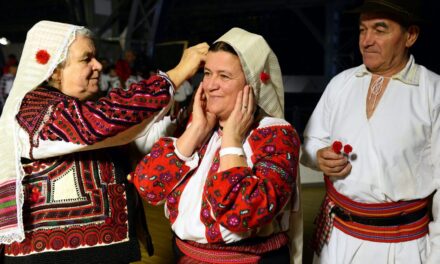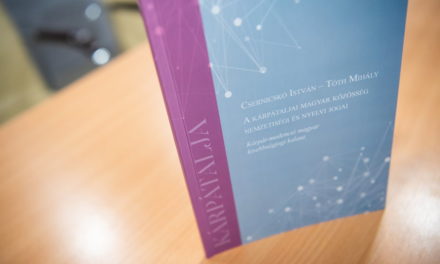Verbal attacks against Hungarians are commonplace in Romania, and the "crusade" taking place in the easternmost part of Székelyföld, in the Úzvölgy Gorge, continues.
Criminal proceedings are underway for incitement to hatred or discrimination in the Úzvölgy military cemetery following the commemoration held by nationalist Romanian organizations on October 22, when the organizations Calle Nemzet Útja (Calea Neamului) and Orthodox Brotherhood (Fratia Ortodoxa) organized a parade on the occasion of Romanian Army Day in the cemetery on the border of Bákó and Hargita counties.
A crowd of about two hundred people, mostly dressed in Romanian national costumes, waving Romanian flags entered the cemetery, where a table was waiting for them.
Romanian military songs and the Romanian national anthem were playing from the loudspeakers. They held an Orthodox ceremony and read out the list of Romanian heroes whose remains they believe rest in the Úzvölgy cemetery.
The participants "Present!" they responded to the names being called with exclamations, and also stretched out a banner with the words "Hungarians, go back to Mongolia, where you came from" and "Hungary is not on the map of Europe". Verbal attacks do not count, nor do they count.
Perhaps this time there will be consequences for inciting anti-Hungarian hatred
Let everyone decide for themselves what is important about the Romanian Army Day - October 25 was declared a holiday during the communist period, and with the accession of Charles the Great, the main objective of the Romanian transition on August 23 was realized on this day in 1944, the liberation of the entire territory of the country from from German-Hungarian occupation, eliminating the legal consequences of the Vienna Dictator of August 30, 1940.
The easternmost part of Székelyföld, the legendary World War II location, the Úzvölgye was already considered a kind of farewell place in communist times.
The cemetery in the lesser-known pass of the Eastern Carpathians, in the valley of the Úz stream, which promised eternal peace to the Hungarians who lived there during the two world fires, was transformed into a worthy memorial site with significant Hungarian state aid after the regime change.
Many people fell on the Mogyorós roof during the Romanian invasion in 1916, and the chapel built a year later preserves their memory.
According to a 1924 census, 1,350 Hungarian, Austrian, German, Italian, Serbian, Russian and Romanian soldiers are buried in separate plots in the area - at least a thousand Hungarians, most of them four from the Royal Hungarian 39th Infantry Division, the 9th from Kassa, the soldiers of the 10th regiment of Miskolc, the 11th of Münkacsi, and the 16th of Bésztercebánya.
During the Second World War, the Soviet army invaded here on August 26, 1944, and the small Hungarian border guard, unable to put up any real resistance, had to flee together with the locals.
The now depopulated Úzvölgye International Military Cemetery, belonging to the village of Csíkszentmárton in Hargita County, became the site of the Romanian-Hungarian conflict four years ago, after thousands of Romanians forced their way into the cemetery on June 6, Romanian Heroes' Day.
Their goal was to participate in the Orthodox consecration of the Romanian plot and monument in the cemetery. Hundreds of Szeklers tried to prevent the assassination with life chains, but without success, it was solely due to the discipline of the Hungarians that the events did not turn into more serious atrocities.
Since then, the dispute about the ownership of the cemetery has been embodied in continuous cemetery demolitions.
Although no Romanian units took part in the 1944 battles in Úzvölgy, the cemetery is referred to as an international military cemetery in official Romanian terminology. This is also apropos of the experiment of the municipality of Dormánfalva (Darmanesti) in Bákó county: they want to show the Romanian identity of the cemetery. There has been a territorial dispute between the village and Csíkszentmárton for years, although according to a 1968 law still in force today, the settlement administratively belongs to Csíkszentmárton.
However, several years ago, the directors of the cadastral offices of Bákó and Hargita counties agreed that the Úz stream would form a more natural border, and they put a stamp to that effect on the maps.
However, according to the law of almost fifty years ago, Csíkszentmárton still has the right to the area, as the cemetery is part of the settlement's public property, which was confirmed by a 2010 government decision. Although the cemetery has always been cared for by the Csíkszentmárton municipality, in April 2019 Dormánfalva arbitrarily created a Romanian plot in it. There are about six hundred wooden crosses at the fenced memorial site with a Székely gate, and concrete crosses commemorating Romanian soldiers have been placed next to them - partly on the cemetery's walkway and partly on the not-yet-marked Hungarian soldiers' graves.
After countless legal and administrative twists and turns in the story, the concrete crosses were removed on June 29, 2023, and they were soon replaced by one hundred and fifty wooden crosses by the supporters of the Calea Neamului organization.
"Satanists, leave the crosses alone! […] If anyone dares to lay their hands on the hundred and fifty wooden crosses, we will return them all, I guarantee that! Today they tear it down, we make new ones and put everything back in place. We are demonstrating in Csíkszereda, Csíkszentmárton, so that the Hungarians get used to the Romanian flag, which was stolen from the cemetery," said Mihai Tîrnoveanu, head of Calea Neamului, in a video message.
Over the past years, a civilian dentist activist from Brasov has become the most ferocious anti-Hungarian agitator in Romania.
Tîrnoveanu, who is at the forefront of the racket, is currently facing criminal charges for vandalism and grave desecration, but he claims that the Hungarian government is exerting political pressure on the Romanian authorities in order to hold him personally and the organization he leads accountable.
Meanwhile, not a single Romanian party distanced itself from the extreme anti-Hungarianism of the recent events in Úzvölgy.
After the parliamentary state secretary of the Ministry of Foreign Affairs and Trade, Levente Magyar, consulted with the Romanian ambassador in Budapest, according to the ministry's information, the latter promised to take action against the scandalous events. Tîrnoveanu called the position of the Romanian ambassador in Budapest outrageous and hoped that the news reports were based on a mistranslation. The patriotism of the speaker is not limited to anti-Hungarianism, he objected, for example, to the education of Romanian history and the teaching of the Holocaust in Romanian schools.
The activist regularly holds provocative tours in the settlements of Székelyföld, but his actions are not accompanied by much success.
The association proclaiming ideological kinship with the Union for the Unification of Romanians, the far-right parliamentary party called AUR, held last year's Romanian national holiday in Kézdivásárhely, but the performance of the delegation that arrived with a large parade of clothes drowned in empty nationalism. Tîrnoveanu and his colleagues also planned an action aimed at preventing Prime Minister Viktor Orbán's speech in Tusvány this year, which, however, was thwarted by the law enforcement officers.
Kelemen Hunor, the president of RMDSZ, urged decisive action on the part of the authorities and state institutions.
According to him, the main conclusion of the lack of official accountability is that state institutions are weak or complicit in the story.
He called it unacceptable that while the Hungarian community is regularly expelled from the country and sent back to Asia, the dominant players in Romanian politics do not condemn what happened. According to him, the Romanian institutions must act decisively against the anti-Hungarian nationalists in Úzvölgy.
In the meantime, the people of Csíkszentmárton will remove the Romanian tricolor raised in the cemetery, since after a commemoration in August, the Hungarian one was also taken down because, according to the cemetery regulations adopted by the local government, the flag can only be flown on the pole during commemorations and celebrations. The Tîrnoveanu's are guaranteed to put it back with the assistance of the law enforcement forces that always come out in large force to similar events. All this will take place in 2023, in the so-called friendly relations of two EU countries.
Cover image: The new wooden crosses placed by the Romanian organization A Nemzet Útja (Calea Neamului) in place of the removed concrete crosses in the Úzvölgy military cemetery on July 11, 2023
Source: MTI/Nándor Veres












